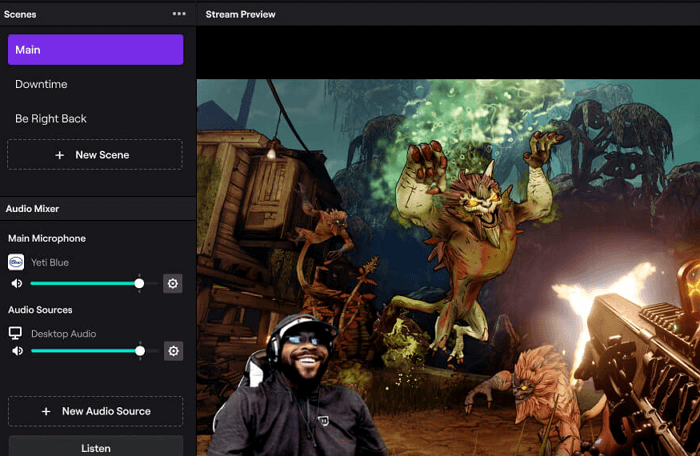Streaming platforms for gaming have exploded in popularity, transforming how we consume and interact with video games. From casual players broadcasting their weekend sessions to esports pros showcasing their skills, these platforms have created a vibrant, global community. This exploration dives into the market leaders, their monetization strategies, the importance of community building, the tech behind the streams, and what the future holds for this rapidly evolving industry.
We’ll cover everything from Twitch’s dominance and YouTube Gaming’s rise to the innovative monetization techniques streamers use to build loyal followings. We’ll also look at the technical side, examining the hardware, software, and internet speeds necessary for high-quality streaming. Finally, we’ll gaze into the crystal ball and predict how advancements in VR/AR and cloud gaming will shape the future of gaming streams.
Popularity and Market Share of Gaming Streaming Platforms

The gaming streaming market is a fiercely competitive landscape, dominated by a few major players but also featuring a number of smaller, niche platforms. Understanding the market share and unique features of each platform is crucial for both streamers and viewers seeking to navigate this dynamic environment. This analysis will explore the current market standing of prominent platforms and delve into the factors that contribute to their individual successes.
Market Share and Platform Comparison
Precise market share figures are difficult to obtain definitively, as different research firms employ varying methodologies and not all platforms publicly release their viewership data. However, by synthesizing data from reputable sources like Statista and StreamElements, we can construct a reasonable overview of the current landscape. The following table presents a comparative analysis, keeping in mind that these figures represent estimates and can fluctuate.
| Platform | Market Share (Estimate) | Unique Features | User Demographics |
|---|---|---|---|
| Twitch | ~70% | Extensive features for streamers (bits, subscriptions, channel points), large and engaged community, robust partner program. | Broad demographic, but skews towards younger male viewers with a strong interest in esports and competitive gaming. |
| YouTube Gaming | ~20% | Integration with YouTube’s massive video platform, strong monetization options through ads and channel memberships, diverse content beyond live streams. | Similar to Twitch, but with a potentially broader audience due to YouTube’s wider reach. |
| Facebook Gaming | ~5% | Integration with Facebook’s social network, focus on community building, potential for cross-promotion with other Facebook services. | Potentially broader demographic than Twitch or YouTube Gaming, reaching users beyond the core gaming audience. |
| Other Platforms (e.g., DLive, Trovo) | ~5% | Niche features, focus on specific gaming genres or communities, often offer alternative monetization models. | Varied demographics depending on the platform’s focus and target audience. |
Factors Contributing to Platform Popularity
Several factors contribute to the popularity of individual gaming streaming platforms. Twitch’s dominance stems from its early mover advantage, establishing itself as the go-to platform for live gaming content. Its robust features for streamers and viewers, along with a strong emphasis on community building, have solidified its position. YouTube Gaming leverages the existing massive user base of YouTube, offering a seamless integration for content creators and viewers alike.
Facebook Gaming benefits from its vast social network, facilitating easy content sharing and community engagement. Smaller platforms often thrive by catering to niche communities or offering unique features not found on larger platforms.
Evolution of the Gaming Streaming Market (Past Five Years)
The past five years have witnessed significant growth and evolution in the gaming streaming market. Twitch has maintained its leading position, but YouTube Gaming has consistently gained market share, largely due to its broader appeal and integration with YouTube’s ecosystem. Facebook Gaming has struggled to gain significant traction despite its considerable resources. The rise of mobile gaming has also impacted the market, leading to an increase in mobile-first streaming platforms.
The emergence of new technologies, such as VR and AR streaming, also presents opportunities for future growth and innovation. The market has seen increased competition, platform diversification, and a growing emphasis on creator support and monetization options. The overall trend indicates a continuing expansion of the market, with increasing viewership and engagement across various platforms.
Monetization Strategies on Gaming Streaming Platforms
Streaming platforms have revolutionized the gaming industry, creating lucrative opportunities for both viewers and content creators. However, the success of a streamer hinges significantly on their ability to effectively monetize their content. This section explores the various strategies employed by streamers across different platforms to generate income.
Methods of Monetization on Gaming Streaming Platforms
Streamers employ a diverse range of methods to generate revenue. The most common include subscriptions, donations, sponsorships, and advertisements. The effectiveness of each strategy varies depending on the platform, the streamer’s audience, and their overall brand. A successful monetization strategy often involves a combination of these approaches.
Subscription Models
Subscription models offer viewers exclusive benefits in exchange for a recurring fee. Platforms like Twitch and YouTube offer tiered subscription levels, providing streamers with a predictable income stream. Higher-tier subscriptions often unlock perks like exclusive emotes, badges, subscriber-only chat access, and increased interaction with the streamer. The revenue generated through subscriptions is typically split between the streamer and the platform, with the exact percentage varying depending on the platform’s revenue-sharing model.
For example, a streamer might receive 70% of the subscription revenue on Twitch, while YouTube’s revenue share can vary depending on factors such as channel membership status and audience engagement.
Donations and Tips
Donations and tips provide a direct method for viewers to support their favorite streamers. Platforms often integrate features like “bits” (Twitch) or “super chats” (YouTube), which allow viewers to donate small amounts of money that are directly transferred to the streamer. Other platforms might use third-party services like PayPal or Patreon for direct donations. While this method offers less predictability than subscriptions, it can provide a significant boost to a streamer’s income, particularly during live streams or special events.
The amount received is usually directly transferred to the streamer with minimal platform fees, making it an attractive option.
Sponsorships, Streaming platforms for gaming
Sponsorships involve partnering with brands to promote their products or services during streams. Streamers might integrate product placements into their content, mention sponsors in their streams, or participate in sponsored events. This approach can be highly lucrative, especially for popular streamers with large and engaged audiences. The compensation for sponsorships can vary significantly depending on the streamer’s reach, audience demographics, and the terms of the agreement.
However, it is crucial for streamers to choose sponsors whose products or services align with their brand and audience to maintain authenticity and avoid alienating their viewers.
Advertisements
Advertisements are a common monetization method on many streaming platforms. Streamers can earn revenue by displaying ads during their streams or incorporating pre-roll or mid-roll ads into their recordings. The amount earned from advertisements depends on factors like the number of views, ad engagement, and the advertiser’s bidding strategy. However, excessive advertising can negatively impact the viewer experience and potentially lead to audience churn.
Many streamers carefully balance ad placements to minimize disruptions to their viewers.
Comparison of Revenue-Sharing Models
| Platform | Revenue Share Percentage (Subscriptions) | Minimum Requirements | Payment Methods |
|---|---|---|---|
| Twitch | 50-70% (varies based on partner program and subscription tier) | Affiliate or Partner status | Direct deposit, PayPal |
| YouTube Gaming | 55% (Channel Memberships) | Channel Membership eligibility | AdSense, PayPal |
| Facebook Gaming | Variable, dependent on contract | Level of partnership | PayPal, Facebook Pay |
The Role of Community and Interaction on Streaming Platforms

For gaming streamers, building and maintaining a strong community isn’t just a nice-to-have; it’s the lifeblood of their success. A thriving community translates directly into increased viewership, higher engagement, and ultimately, more lucrative monetization opportunities. The connection forged between streamer and audience creates a loyal following that returns for more, supports the streamer financially, and actively promotes their channel.
This symbiotic relationship is crucial in the competitive landscape of gaming streaming.The success of a gaming stream hinges heavily on the platform’s ability to facilitate meaningful interactions between streamers and their viewers. Different platforms offer varying degrees of support for community building, employing various tools and features to enhance the experience. These features directly impact a streamer’s ability to cultivate a loyal and engaged audience.
Effective communication and fostering a sense of belonging are paramount.
Platform Features that Facilitate Community Building
Gaming streaming platforms offer a variety of features designed to boost community engagement. These features range from basic chat functions to more advanced interactive elements. The effectiveness of these tools depends on how well streamers integrate them into their streaming strategy. For instance, a simple chat function allows for real-time conversation, while emotes add personality and visual expression to the interaction.
Interactive elements, such as polls, quizzes, and games integrated into the stream, can actively involve viewers in the content, fostering a sense of participation and ownership. Twitch, for example, is known for its robust chat system and extensive emote library, while YouTube Gaming allows for live chat interaction and community posts. Discord servers often serve as an extension of the streaming platform, providing an additional space for community members to connect outside of live streams.
Examples of Successful Streamer-Audience Interactions
Many successful streamers have demonstrated the power of community engagement. Consider the example of a popular streamer who regularly incorporates viewer suggestions into their gameplay, creating a collaborative and inclusive streaming experience. This demonstrates a proactive approach to building a strong community by actively valuing viewer input. Another example might involve a streamer who regularly hosts Q&A sessions or dedicated community events, fostering a sense of connection and personal interaction beyond simply playing games.
These strategies cultivate a sense of belonging and loyalty among viewers, encouraging repeat viewership and active participation in the stream’s chat. Streamers who actively respond to comments, acknowledge individual viewers, and build personal relationships with their audience often see significantly higher engagement and loyalty. This personalized approach is key to cultivating a strong, supportive community.
The Future of Gaming Streaming Platforms

The gaming streaming landscape is poised for significant transformation in the coming years. Technological advancements, shifting viewer preferences, and intense competition are all shaping the future of how we consume and interact with gaming content online. We can expect to see a convergence of technologies, a heightened focus on personalized experiences, and the continued evolution of monetization strategies.
Technological Advancements and Viewer Preferences
Technological advancements will be a primary driver of change. Higher bandwidth availability and the continued rollout of 5G will allow for higher-quality streaming, including 4K and even 8K resolution, with significantly reduced latency. This will be crucial for competitive gaming streams, where even milliseconds of delay can make a difference. Viewer preferences are also evolving; we’re seeing a growing demand for interactive streaming experiences, personalized content recommendations, and more integrated social features.
Platforms that successfully cater to these evolving needs will likely thrive. For example, the increasing popularity of mobile gaming will likely lead to more platforms optimizing their services for mobile viewing and interaction, perhaps even incorporating features that allow for seamless transitions between mobile and desktop viewing. The rise of short-form video content, mirroring the success of platforms like TikTok and Instagram Reels, may also influence gaming streams, leading to more concise, highlight-reel-style content alongside longer, traditional streams.
The Impact of VR/AR and Cloud Gaming
The integration of virtual reality (VR) and augmented reality (AR) technologies presents exciting possibilities. Imagine VR viewers experiencing a game from the perspective of a streamer, or AR overlays adding interactive elements to the stream itself. This could revolutionize how viewers engage with gaming content, creating far more immersive and interactive experiences. Cloud gaming, which allows users to stream games without needing powerful hardware, is another game-changer.
It will democratize access to high-quality gaming experiences, potentially expanding the audience for gaming streams exponentially. This could lead to a surge in new streamers and viewers, increasing competition but also creating a larger overall market. Think of the impact of platforms like GeForce Now and Stadia; as these mature and improve, their influence on the streaming landscape will only grow.
A Hypothetical Future Scenario: StreamVerse in 2028
Five years from now, imagine a platform called “StreamVerse.” StreamVerse integrates seamless VR/AR experiences, allowing viewers to choose between traditional 2D viewing, a limited VR perspective embedded within the game world, or even AR overlays that let them interact with elements of the stream using their smartphones. The platform utilizes advanced AI to curate personalized content recommendations based on individual viewing history and preferences.
Monetization goes beyond traditional subscriptions and ads; viewers can purchase virtual goods to use within the VR/AR experiences or tip streamers using cryptocurrency. The platform emphasizes community building through sophisticated social features, including virtual meetups, collaborative game sessions within the stream, and enhanced chat functionalities that facilitate real-time interactions between streamers and viewers, fostering a more vibrant and engaging community.
StreamVerse’s user interface is intuitive and user-friendly, regardless of the chosen viewing method, catering to both casual and hardcore gamers. The platform will also incorporate advanced analytics to provide streamers with valuable insights into their audience, enabling them to better tailor their content and build a loyal following. This comprehensive approach, blending cutting-edge technology with a focus on community and personalization, positions StreamVerse as a leader in the evolving gaming streaming landscape.
Impact of Streaming on the Gaming Industry: Streaming Platforms For Gaming

Streaming platforms have fundamentally reshaped the video game landscape, impacting everything from game design to marketing strategies and the careers of those involved in the industry. The accessibility and reach provided by platforms like Twitch and YouTube Gaming have created a powerful feedback loop, influencing how games are developed, marketed, and ultimately played.The rise of streaming has directly influenced game development in several key ways.
Developers are increasingly designing games with streaming in mind, incorporating features that are visually appealing to viewers, enhancing the spectacle of gameplay. This often translates to more visually striking games with elements designed to be easily understood and appreciated by a wider audience, even those not actively playing. For example, the popularity of battle royale games like Fortnite, with its vibrant visuals and easily digestible gameplay, is partly attributable to its inherent stream-ability.
The emphasis on short, exciting moments perfect for capturing attention on stream has become a significant design consideration.
Game Development and Marketing Influenced by Streaming
The integration of streaming into game marketing is now a critical component of a successful launch. Many games now include built-in streaming features, and developers actively collaborate with streamers to generate hype and reach a wider audience. Early access and beta testing phases are often heavily promoted through streaming, allowing developers to gather feedback directly from potential players and build a community before the official release.
This allows for direct engagement with the audience, gathering valuable insights that can be used to refine the game before launch. The success of games like Among Us, which exploded in popularity thanks to extensive Twitch and YouTube streams, demonstrates the power of this approach.
Streaming’s Impact on Professional Gamers and Game Developers
Streaming has created entirely new career paths for both professional gamers and game developers. Successful streamers can earn substantial incomes through subscriptions, donations, sponsorships, and advertising, creating a viable alternative to traditional employment. This has led to the rise of esports as a professional sport, with top gamers commanding significant salaries and endorsements. Similarly, game developers can leverage streaming to directly connect with their audience, gaining valuable feedback and building a loyal following.
This direct engagement allows for a more iterative development process, enhancing the overall game experience. The career trajectory of many successful game developers now involves substantial interaction with the streaming community, allowing for a more agile and community-driven development process.
Frequently Asked Questions
What’s the best streaming platform for beginners?
Twitch is generally considered the easiest to start with due to its large community and readily available resources.
How much money can I make streaming games?
Earnings vary wildly depending on viewership, sponsorships, and donations. Some streamers earn a modest income, while others make a substantial living.
What kind of equipment do I need to stream?
At minimum, you’ll need a gaming PC or console, a decent microphone, a webcam (optional), and a stable internet connection. Higher quality streams require more powerful hardware.
How do I get more viewers on my stream?
Consistency, engaging content, interacting with your chat, and promoting your stream on social media are key strategies.
